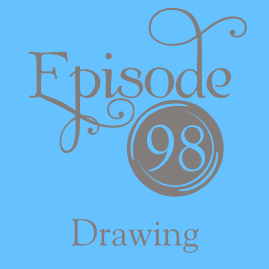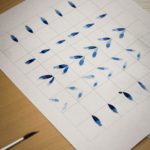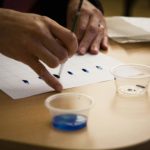
Listen Now:
- Brush Drawing Lessons
“It is only what we have truly seen that we can truly reproduce, hence, observation is enormously trained by art teaching. Personally, I believe every living soul can learn to draw from actual objects, if the eye has not first been vitiated by seeing copies of them.” (Miss Pennethorne, PR 10)
“This is what we wish to do for children in teaching them to draw–to cause the eye to rest, not unconsciously, but consciously n some object of beauty which will leave in their minds an image of delight for all their lives to come.” (Vol. 1, p. 313)
“Art, when rightly directed, is educational, for it trains not only one faculty, but all the faculties together; it trains the hand and the eye, and it trains the head and the heart; it teaches us to see and to see truly; it teaches us to think–that science can do; but it teaches us also to admire and to love; it disciplines the emotions.” (Mr. Collingwood, The Fesole Club Papers)
“…the great benefit of “brushwork” being that it can be made quite a moral training in exactness and decision.” (Mrs. Perrin, “Brush Drawing”, PR 4)
“Children should learn to draw as they learn to write. The great point is that they should be encouraged, not flattered. With no help and encouragement the child gradually loses his desire to draw.” (Mrs. Steinthal, “Art Training in the Nursery”, PR 1)
“There are two great points that must be remembered if we wish to make our system of art teaching…successful. The first is, always keep the children interested. Next, let us understand that drawing is not only learnt with a pencil and a piece of paper….The chief value of drawing is that it trains the eye to see things as they are.” (Mrs. Steinthal, PR 1)
“…we must be careful not to offer any aids in the way of guiding lines, points, and other such crutches; and also that he should work in the easiest medium; that is, with paint-brush or with charcoal, and not with a black-lead pencil. Boxes of cheap colours are to be avoided. Children are worthy of the best.” (Vol. 1, p. 313)
“The first buttercup in a child’s nature note book is shockingly crude, the sort of thing to scandalise a teacher of brush-drawing, but by and by another buttercup will appear with the delicate poise, uplift and radiance of the growing flower.” (Vol. 6, p. 217)
“Drawing is nothing to do with talent, but can be done with observation, intelligence and application–or by seeing, remembering and expressing and is a fundamentally educative subject.” (Juliet Williams, “The Teaching of Drawing and Its Place in Education”, PR 34)
School Education (Volume 3), p. 205
Ourselves (Volume ), Book I, Part II, Chapters II and V
An Essay Towards a Philosophy of Education, Book I, Chapter X (f)
Drawing on the Right Side of the Brain, Betty Edwards
(Affiliate Links)
Dallas Nachtigall’s Bestowing the Brush Drawing Courses
Drawing Lessons, Florence Monkhouse (PR Article)
Brush Drawing, Miss K. Loveday (PR Article)
The Teaching of Drawing and Its Place in Education, Juliet Williams (PR Article)
Brush Drawing, Mrs H. Perrin (PR Article)
Fesole Club Papers, Mr. W. G. Collingwood








My 7yo daughter was stuck in the van with me a couple days ago. Or I was stuck in the van with her? She’s a chatty little thing, so I turned on this podcast to catch a little break. She got so quiet that I thought she had fallen asleep. No. Eventually, she announced, “I’m listening to this. It’s really interesting. But what’s all the ‘no pencil’ stuff?”
She refuses to draw with anything but a pencil.
Now, this morning, she is curled up next to me. She’s drawing, as usual. But I notice that she has a … pen. 🙂
Hahaha! The point (pardon the pun) of not using pencil (and a pen would be similar, as you know!) is that it makes the child focus on the details before the overall form. I think she can draw in her free time with pencil as much as she wants, and keep giving her drawing lessons with other media in the morning. Tell her that I very much regret not drawing out of my comfort zone and am working on those areas I’m not strong in either. We can grow in our abilities together.
Emily
Is it ok if the child draws in pencil or pen for pleasure? I was planning to do charcoal and oil pastels and watercolors for our Drawing time starting in January. I prefer the charcoal sticks and oil pastels as they are, but my sister had recommended charcoal pencils and some other artsy mom had mentioned Slick Stix to me as alternatives. After listening to this podcast, I’m wondering if those latter options would be considered the same as a pencil or would still be ok? Just curious. 🙂
Hi Rachel,
Absolutely allow pen and pencil for pleasure drawing. The point of not using pencil is that the child will draw the details before the whole overall form, so I would tend to stick to the recommendation of Vine (soft) charcoal and traditional chalk pastels. I would not recommend charcoal pencils as the result will be the same, or very similar, to pencil.
This was SO helpful! How to think about the different kinds of drawing (imagination, memory, from objects) and how it relates to nature study/special studies. I was also wondering about the Book of Centuries. I am pretty sure I remember you mentioning that using brush drawing in the Book of Centuries would likely be too messy, so is that an exception to the no-pencil rule? Also, since visits to the British Museum are not a once-per-term event for us here in Ohio (sadly) most of our history drawings are from pictures not artifacts… where do they fit into things?
Thanks
Hi Nancy,
The instructions for the Book of Centuries specify ink–pen, pencil will smudge and not be a good medium as the BOC is meant to be kept for your entire life.
Do you have any kind of museum? The programmes don’t specify that the British Museum needed to be the site of artifacts drawn, rather local museums. If you don’t have access to a museum, you will have to draw from the flat, but I don’t think this violates a principle as children would have been drawing from the round for at least 4 years before beginning a BOC, and should be well prepared.
Is vine / soft charcoal the kind of thing that looks like this photo?
https://i.pinimg.com/736x/95/44/d7/9544d7be8536ce732337709b880181b2.jpg
Yes ma’am!
Thank you so much!
Are there different instructions for the different types of media? How do you introduce them to your 1b. I am looking theought some of the linked books, but am missing this piece. Thank you so much for these.
Have you read the linked article by Juliet Williams? She gives great step by step instructions for setting up a specimen and how to guide your children to observing it closely, pointing out the major line segments, shapes, etc. I would encourage lessons in brushdrawing and let the child choose chalk/soft pastel or charcoal if they want. For these early years, using those materials will be a matter of trial and error rather than deliberate instruction.
Emily
I did and I admit, I am a bit overwhelmed by it. She said she gives instruction, but i see drawing and with brush in hand stare blankly at the paper or come up with a boring two dimensional object. I need a basic book for me because line segment? I do not get.
Laurie,
If you are feeling limited by your own lack of knowledge, I’d highly recommend working through The Fesole Club Papers, also linked in the show notes, for yourself. Lessons for a IB student would be very simple, and you would gain much knowledge simply by working through those yourself.
Thank you. You ladies have been a tremedous resource.
Thank you very much for this podcast. It’s incredibly interesting. I am curious as to how often they had to draw from memory. I can understand the need to do so; since the best option is to draw from life, and if the object isn’t near you to study, then it has to be done from memory. My concern is that as a child continues to grow, they could rely more on their memory than the real object when attempting a drawing. In all of the art classes I have taken (from childhood up through college) the #1 thing to remember is draw what you see, not what you think you see. It is instinctual for our brains to want to take over instead of letting the eye tell our hand what to do. I can see the benefits of drawing from memory as a means of strengthening attentiveness, but if it is done more often than direct observation, it could backfire on the students’ ability to slow their brain down enough to draw what they see.
Hi Paula,
I do understand what you’re saying, however, it’s extremely important to first understand what *Miss Mason* meant, and not try to fit her ideas into our existing paradigms. (This has often been very hard for me too.)
It is crucial to understand what she meant with memory drawings–they were *always* based on very close and exact observation. It was a way of building observation, not, as you are relating, a time for children to draw what they *think they know* about an object. You begin by having them examine a specimen very closely, cover it, then have them draw what they saw. Uncover the object, and have them study it again comparing their drawing to the actual specimen. This is very effective for building a bank of correct observations that will serve them all their days afterwards. I highly recommend reading Juliet Williams’ article linked above in the show notes. She offers very practical and inspirational ideas for implementing this practice with children.
Apart from the 6 drawing of animals students had *been able to closely observe* per term, there wasn’t a specified amount of memory drawing required. They would do some every term, but it wasn’t prescriptive.
Emily
Can you please share the volume/date info for Ms. Williams’ article? Thank you so much!
It is Parents’ Review Volume 34, I believe the January issue. (It’s not available online anywhere but through the link shared above)
Thank you! I have been tantalized by a comment in one of the PNEU articles from 1899 that stated the “scheme of drawing instruction” would be printed in the next couple months. I have not found anything shortly after that about art or drawing. This article was fantastic with all the suggestions it gives. I really appreciate you sharing it!
You’re very welcome!
My apologies… that article I mentioned was an 1897 one, not 1899. Thanks again.
Pingback: The Importance of Memory Drawing in Nature Notebooks by Emily Kiser - Charlotte Mason Institute
Did Ms. Mason have the kids use sketchbooks? I see that they started out using chalk on a chalkboard to avoid pencils. But at any point did they switch over to sketchbooks?
Thank you.
They did do drawings on paper from the beginning as well. The chalk and chalkboard isn’t just to “avoid pencils” but gives the child practice with a less permanent medium. I don’t think it is necessary to keep all drawings in a single sketchbook, nor have I found mention of drawing notebooks apart from the nature note-book which was in use as an adjunct to nature study, and could contain some of the nature drawings, I suppose. Sketchbooks were also not prevalent the way we think of them at the time. This is an area that you are free to determine how best to apply the practice in your own home: a portfolio with loose drawings in single sheet paper, or, a sketchbook with all drawings contained inside. It’s up to you!
I’m sorry if this is repeat question. I am only half way through this episode and keep getting interrupted. I wanted to purchase some good brushes as I am working my way through listening and all the supplemental reading. What size of brush should we be using? And it’s a round brush I’m pretty sure? Any brands that you like that won’s break the bank?
Hi Jessica,
This is a really tough question to answer because brushes vary so much from company to company. Even the sizes! Generally, I would encourage you to look for a short-handled brush made of good quality synthetic or synthetic/natural blend (our nice synthetic brush material has come such a long way over the years and will be better for a beginner in the shape retention and control) in a size 4 and 6. They should be medium sized round brushes, some companies’ 4s are TINY! If I find a “perfect” brush to recommend, I’ll at it in the show notes! I’ve been experimenting with so many!
Emily
Thanks Emily! I went ahead and bought a set of medium to medium small round brushes and one medium individually sold round brush so we could try them out. I just bought what was at Hobby Lobby, but not the cheap stuff ? And not the most expensive either! ?We’ll see how the works!
Hi there! I have been reading some of the linked articles and I am confused about the materials I ought to use to start to teach drawing. I have no personal expertise with drawing or art of any sort so this is one of the most intimidating subjects for me to try to teach (particularly since I cannot just let the book or author be the teacher!). When reading the “Brush Drawing” article, the author said to start with a brush because your lines must be perfect and correct the first time and brushdrawing doesn’t allow for alterations or “finicky work” (page 2). But when I read the first article “Drawing Lessons”, she says to start with charcoal and French paper because “alterations can be easily made”. How do I think through these seemingly opposing principles? Also, most of the the drawing lessons mentioned in the linked articles seem to focus on drawing objects that are present, but in the podcast you guys mention children drawing “Jack and the Beanstalk”. How does that sort of drawing relate to actual drawing lessons?